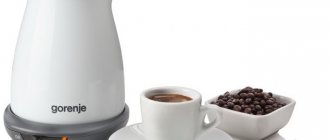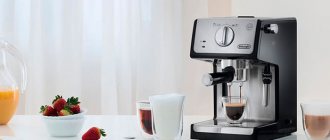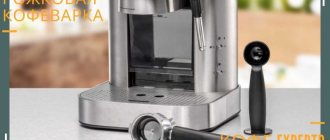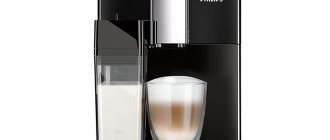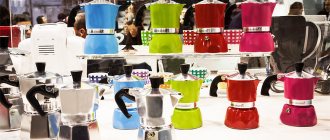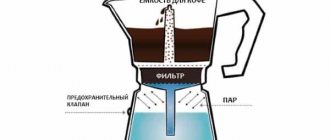Enjoy your coffee!
There is always room for experimentation - try different grains, change the grind size, add clear juices - apple or cherry - to the water. Try adding coffee to the top flask immediately after raising a small amount of water, wait until the water has completely risen, remove the burner and place a few ice cubes or frozen fruit slices in the top flask to stop the brewing process.
Life hack: A siphon is also an excellent device for brewing not only coffee, but also tea; try brewing Pu-erh in it, and you will get an excellent tea drink.
Read our articles about how to make coffee in other coffee gadgets.
What is a coffee siphon
A coffee siphon is one of the devices for making coffee. It consists of two flasks connected by a tube. Water is poured into the first flask and heated (usually with an alcohol burner), a filter is installed in the second flask and ground coffee is poured.
What happens in the siphon?
- When water heats up, it expands.
- The increasing pressure forces hot water into the second reservoir.
- The ground powder is extracted under the influence of hot liquid.
- Gradually, almost the entire volume of water passes through the tube from the heated flask into the flask with coffee, and warm air is displaced along with it. It is this that causes the coffee to bubble in the second part of the device.
- After heating stops, the liquid is poured into the first vessel under the influence of pressure differences and gravitational forces. The filter retains powder particles, and the flask contains the purest, aromatic drink.
Design
The siphon for brewing coffee consists of the following parts:
- lower flask made of heat-resistant glass. It comes in teardrop-shaped and round shapes;
- metal tripod. The lower reservoir is fixed on it. This leaves free space necessary for installing the heating element;
- top flask. Borosilicate glass is used for its manufacture. This design part comes in spherical and cylindrical shapes. At the bottom it is equipped with a long tube that plunges into the lower reservoir;
- lid;
- rubber compressor. It is placed between the upper and lower flasks;
- filter. Made from textile or metal. Placed at the top;
- heating source . Often a regular alcohol burner is used.
How to choose a tea siphon
When choosing a siphon, you should pay attention to the following points:
- Gas-burner. It should be comfortable, well adjustable, and should not have any foreign odor.
- Good glass flasks. The glass must be high-temperature tempered.
- Metal filter. It will last longer and is more reliable than regular fabric.
- High quality tires. The rubber gasket connects the flasks; it should not be too soft.
- Manufacturer. It is worth paying attention to two manufacturers of siphons: Hario from Japan and Yama Glass (Taiwan).
Please note before purchasing...
So, you have read the reviews of the best siphon coffee makers available in the market. Let's see what other useful things you need to know about the device and the process itself.
Is the coffee maker freestanding or stovetop?
Siphons can be used both autonomously and on a stove. The quality of the coffee does not depend on this.
A stand-alone siphon coffee maker prepares coffee using a built-in or separate burner, which is located under the lower chamber. The burner can be either alcohol or gas.
There is another type of siphon coffee makers that operate on an electric or gas stove. Keep in mind that you will need to place a diffuser between the device and the heating element. Direct contact with heat can increase the likelihood that cracks will develop in the lower chamber.
We prefer freestanding siphons that look vintage and meticulously detailed. True, such devices are slightly more expensive than simpler models that work on the stove.
Materials
Preparing coffee using the siphon method has been used since the 1830s. At that time, devices were made of brass and stainless steel. Such models can still be found. True, now they will rather play the role of decor, paying tribute to the old times. Such devices are unlikely to be practical.
Nowadays, the bodies of the best, high-quality siphons are made of heat-resistant borosilicate glass. This, of course, does not mean that the devices become indestructible. If you take care of them carefully, they will last you a very long time.
Filters
Most siphon coffee makers use fabric filters, which are great for sifting out coffee particles. However, such filters are difficult to clean. If you don't want to bother, choose a model with a stainless steel filter. Cleaning these filters is very simple.
What about burners?
If you decide to purchase a stand-alone coffee maker, then it should come with a burner. Different burners are combined with different models of siphons.
The most commonly used burners are butane, gas and alcohol burners. Newer machines may use electric or halogen burners.
The alcohol burner is the cheapest. However, you may find it difficult to control the temperature until you get the hang of it. You may also find that there will be a lot of soot left at the bottom of the siphon.
We prefer gas or butane torches. They are usually quite reliable. They are easier to use and control than alcohol burners and will not leave soot marks.
How many servings of coffee do you want to make?
Like many other systems, siphons can produce different amounts of coffee. Usually you can prepare from 3 to 8 mugs at a time. Don't forget to check the coffee maker's capacity before purchasing to make sure it suits your coffee consumption level.
What's your budget?
When it comes to choosing the perfect siphon coffee maker, you need to pay special attention to the budget you have.
If this is your first time making coffee using a siphon, you probably won't want to spend too much money. True, it is very difficult to look away from some top-category models...
Geography of tea
How to pay?
Cash payment:
Produced upon receipt of the order and available for any delivery method except mail and EMS
Payment by card:
Best2Pay, Visa, MasterCard, MIR
Payment by bank transfer can be made for any delivery method
Payment security:
You can pay for your order using bank cards of Visa, MasterCard, MIR payment systems. When paying by credit card, payment security is guaranteed by the Best2Pay processing center.
Payments are accepted through a secure secure connection using the TLS 1.2 protocol.
Best2Pay complies with international PCI DSS requirements to ensure secure processing of the payer's bank card details.
Your confidential data necessary for payment (card details, registration data, etc.) are not sent to the online store; they are processed by the Best2Pay processing center and are completely protected. No one, including the online store geotea.ru, can obtain the payer’s banking and personal data.
When paying for an order with a bank card, a refund is made to the same card from which the payment was made.
How to order?
1 way
:
Add the desired product to the cart and, if necessary, specify the quantity;
Enter your email address;
Click the “Place an order” button;
Select a delivery method;
When selecting “Pickup”, enter your name and phone number and click “Continue”;
Select a payment method;
If necessary, leave a comment on the order;
When selecting the “Delivery to address” item, enter all the proposed data including the postcode, click “Continue”;
Select a convenient delivery method, click “Continue”;
Select a payment method;
If necessary, leave a comment on the order;
Congratulations, your order has been completed!
Method 2:
Contact the manager or send your order to us by email
Purchase returns
We draw your attention to the fact that food products (including tea) are of proper quality and the goods listed in the “List of non-food products of proper quality that cannot be returned or exchanged for a similar product of a different size, shape, size, style, color and configuration ", approved by Decree of the Government of the Russian Federation of January 19, 1998 No. 55, are not subject to exchange or return.
In accordance with the norms of the current legislation of the Russian Federation, you, as a consumer, have the right to demand from us:
exchange a product of proper quality that does not meet any characteristics for another product within 14 days from the date of purchase of the product (non-food product); return a product of proper quality within 7 days after its receipt (non-food product); replace or return a product of inadequate quality. Exchange of an unsuitable product of proper quality for another product within 14 days from the date of purchase of the product (non-food product)
An exchange of goods of good quality is possible if its presentation (packaging, seals, labels), consumer properties, as well as a document confirming the fact and conditions of purchase of the specified product (sales or cash receipt) are preserved. To exchange goods, an identification document is also required. Due to the peculiarities of the remote sales method, replacement of goods can only be performed by returning the goods of proper quality and placing a new order for a similar product.
When exchanging goods of proper quality, we reserve the right to conduct an examination of the goods in order to determine its quality and safety of consumer properties.
For information about exchanging goods, see the section “Procedure for making quality claims, exchange and return of goods”
Return of goods of good quality within 7 days after receipt (non-food goods)
Based on Art. 26.1. Law of the Russian Federation “On the Protection of Consumer Rights” You can refuse the ordered goods at any time before receiving it, and after receiving it - within 7 days. Returning a product of proper quality is possible if its presentation (packaging, seals, labels), consumer properties, as well as a document confirming the fact and conditions of purchase of the specified product (sales or cash receipt) are preserved. To return goods, an identification document is also required.
If you return a product of proper quality, we will refund its cost no later than 10 days from the date of receipt of the product and your written application; however, within the specified period, we have the right to conduct an examination of the product in order to determine its quality and safety of consumer properties. If the buyer refuses the goods of proper quality, the cost of delivery of the goods is not refunded.
In accordance with the law, goods of proper quality are not subject to exchange or return:
Having individually defined properties, if the specified product can be used exclusively by the buyer purchasing it; Indicated in the list of non-food products of good quality that are not subject to return or exchange, approved by Decree of the Government of the Russian Federation of January 19, 1998 No. 55. To obtain information about the return of goods of good quality see section “Procedure for making quality claims, exchange and return of goods”
Replacement or return of goods of inadequate quality
A product of inadequate quality means a product that is defective and cannot ensure the performance of its functional qualities. If any defects in the product are identified during operation during the warranty period, we recommend that you carefully read the product's operating instructions in order to independently determine whether all requirements for the operation of the purchased product are met in accordance with the specified instructions.
The appearance and completeness of the goods, as well as the completeness of the entire order, must be checked by the recipient at the time of delivery of the goods (except for delivery by mail or transport companies). When delivering the goods, you put your signature on the sales receipt in the column: “I accepted the order, complete set, I have no complaints about the quantity and appearance of the goods. I have read the terms and conditions for returning goods."
After receiving the order, claims regarding external defects of the goods, their quantity, completeness and presentation are not accepted.
If you were given a product of inadequate quality, and it was not agreed upon in advance by the seller, you have the right to take advantage of the provisions of Art. 18 of the Law on Protection of Consumer Rights.
You have the right to refuse to fulfill the purchase and sale agreement, return the goods of inadequate quality and demand a refund of the amount of money paid for the goods within 15 days from the date of transfer of such goods to the consumer.
Any of the listed requirements must be presented by you in writing by filling out an application, see the section “Procedure for making claims to quality and returning goods.”
Requests for the return of the amount of money paid for goods must be satisfied within 10 days from the date of presentation of the corresponding demand (Article 22 of the Law of the Russian Federation “On the Protection of Consumer Rights”).
The procedure for submitting quality claims, exchange and return of goods
In case of claims regarding the quality of goods, exchange or return, the procedure is as follows:
1. Fill out the appropriate application:
Application for return/exchange of goods of proper quality. Application for return of goods of inadequate quality
Please note that a refund in accordance with the current legislation of the Russian Federation is possible only in the form in which payment for the goods was made. If you pay for goods by credit card, cash refunds are prohibited; the transferred funds will be returned to your bank account within 5-30 business days (the period depends on the bank that issued your bank card).
Reason: clause 2 of Bank of Russia Directive No. 1843-U dated June 20, 2007 and Letter of the Central Bank of the Russian Federation dated August 1, 2011 “On the return of funds for goods (services) previously paid using a payment card.”
2. Attach a sales and/or cash receipt
The absence of a sales/cash receipt or other document certifying the fact and conditions of purchase of the goods is not a basis for refusal to satisfy your requirements, however, we reserve the right to verify the fact of purchasing the goods in our online store.
Also, when returning, you must have with you a document proving the identity of the buyer, and in the case of remote transfer of goods, attach a copy of its main spread to the return.
3. You can contact all of the above documents at the following address: St. Petersburg, st. Karavannaya, 11/64, metro station Gostiny Dvor.
Buyers from other regions must return the goods by the same transport company that delivered the goods (or coordinate the transport company with the manager handling the order by phone or mail
In addition to the documents listed above, you must:
hand over the goods fully assembled, with all components and a full set of accessories specified in the technical documentation (technical passport or a document replacing it); attach the conclusions of service centers if you contacted them.
For additional information, as well as to consider claims regarding the quality of the product individually and make a decision, we ask you to send a request to the Claims Department. We ask you to describe in detail the problem you encountered with the product. We will try to find the best solution for you.
Why do we need a siphon today?
Indeed, in our age, with the availability of various modern types of coffee machines, why such an outdated, unsightly-looking device?
It's very simple: the incredible flavor bouquet in a small cup of coffee justifies all the costs. It’s not for nothing that baristas often use it in their competitions. Who else but them knows a lot about real coffee?
Basic rules for using a siphon
I can’t help but mention some rules for the safe use of a siphon:
- Jigger - types, shapes, styles, measurements and rules of use. 120 photos of jiggers for strong alcohol
Whisk: models, designs, tips for use and features of choosing a whisk (135 photos and videos)
Zest knife - description of a quality tool, use of equipment and use of zest (85 photos and videos)
- Use grips or gloves when handling hot parts of the siphon
- Use a special gabet stand
- Use the device again only when it has cooled down
- If there are children in the house, it is better to keep your siphon away from them.
Popular models on the market and approximate cost
The most popular models are:
- The Japanese company Hario offers a wide range of coffee siphons. The advantage of designs from this company is their compactness. The average price of a device from such a company is 5000-7000 rubles.
- The electric siphon is designed specifically for those coffee lovers who do not want to bother with the burner. For such a model you will have to pay approximately 8,000 rubles.
- Retro-looking devices will be appreciated by true lovers of coffee and the history of this drink. Such designs look very picturesque. The approximate cost is 7000-9000 rubles.
Chinese manufacturers offer simple versions of siphons for 3000-4000 rubles. But such designs are only suitable for use at home.
Historical background on the coffee siphon
The first mention of this device dates back to the beginning of the nineteenth century. True, the exact date of its invention is unknown. Moreover, the first patent for a coffee siphon was issued in Germany in 1830.
In the forties of the nineteenth century, the device was improved thanks to the efforts of the French engineer L. Gabet. Subsequently, the siphon began to be called in honor of this scientist (gabet).
The invention gained enormous popularity in France and Germany in a short period of time. It was used to brew coffee in the presence of guests. It was one of the most fashionable entertainments of the time.
True, fame and fashion are fleeting. Interest in the device gradually disappeared. By 1970, there were only a few companies left making coffee siphons. It was only in the early 2000s that gabets again attracted the attention of coffee lovers.
Today, coffee is being prepared using a siphon in European and American coffee shops.
Siphon selection and price
Here you will find out the price of a coffee siphon:
I consider the Japanese Hario to be the leader in the gadget market. The manufacturer produces modern siphons in the price range of 8-16 thousand rubles. Of course, you can find older models with a smaller volume for 4-6 thousand. rubles
There are options to contact our Chinese brother. Their marketing strategy, as you know, usually involves more customer-friendly pricing policies. On average they cost from 2-3 thousand rubles. On the well-known aliexpress.com you can find models starting from one thousand rubles.
If you want to feel the atmosphere of antiquity and enjoy that same “coffee show,” you should buy retro siphons at a price of 7-9 thousand rubles.There are also electric options for 5-8 thousand rubles. You don't need to fuss with them, they are very easy to use.
Safety regulations
When using a siphon, you must adhere to the following safety rules:
- Do not touch glass tanks with bare hands. You need to use fabric gloves or oven mitts;
- Durable glass is used to make the flasks, but the risk that it will break still remains . Therefore, tanks must be handled with care;
- The burner should be refueled away from fire sources and heating devices. Perform these steps only after the heating element has completely cooled down;
- It is strictly prohibited to heat the gabette for more than ten minutes. The lower reservoir may burst.
Brewing coffee in a gabette
Gabet is an excellent tool for experimenting with making black coffee. With this brewing method, the refined taste of elite single-origin coffees is well demonstrated, but inexpensive blends of 100% Arabica beans are also suitable. An exotic drink with an unusual taste is made from a mixture of Arabica coffee with 20–25% excelsa.
Robusta adds bitterness to coffee. Only fans of very strong coffee like to brew robusta in a gabette. But even in this case, it is undesirable for Robusta to be more than 20%.
Any degree of roasting is allowed, grinding is medium or fine (but not dusty). If the beans are ground too coarsely, the taste of the drink will not be rich enough.
To brew coffee in a siphon, you need soft bottled water with a mineralization of 75 to 250 mg/l.
To obtain coffee of moderate strength, take 26 g of freshly ground beans per 360 ml of water (at the rate of 7.2 g of ground coffee per 100 ml of water).
Making coffee in a vertical rack
- Place the filter on the bottom of the upper vessel, level it and secure it (in many models, the filter is attached to the lower edge of the tube using a chain with a hook).
- Pour water into the lower vessel.
- Turn on heating.
- Place the upper vessel with the tube on the lower one.
- After the water boils in the lower vessel, pour coffee into the upper one.
- Water will begin to flow into the upper vessel. Gently stir the coffee. Brewing lasts 1 minute 10 seconds.
- Turn off the burner or heating element. Stir the coffee until the liquid is absorbed into the lower vessel.
History of Gabet
In Western Europe, unlike Eastern Europe, love with a Turkish woman did not work out. From the 18th to the 19th centuries, European coffee lovers tried to come up with a device that would allow them to prepare aromatic and tasty coffee.
In the 30s of the 19th century, coffee makers, consisting of two spherical vessels connected by a tube, came into fashion. Water was poured into the lower container, a filter was placed at the bottom of the upper container and coffee was poured. The lower container was heated. When the water boiled and steam formed, under the pressure of which it was forced out of the lower vessel into the upper one, where the coffee was brewed.
After this, heating was stopped. As a result, a vacuum was created in the lower vessel, due to which the finished coffee from the upper container was sucked into the tube and flowed down. The lower vessel was equipped with a tap, with which it was easy to pour coffee into cups.
It is believed that the first person to come up with such a design was the Berlin inventor Loeff. History has not brought us images of the coffee maker he created. But in 1841, a certain Madame Vassier from Lyon patented a device that differs from modern siphon models only in the decorative crown crowning the upper ball (Fig. 1).
Fig.1. Coffee maker patented by Madame Vassier
The coffee in the siphon turned out excellent: aromatic and not overcooked, since the ground beans were in contact with hot water and not boiling water. Initially, candles and oil lamps were used to heat the lower ball, but it turned out that the best option was an alcohol burner.
Advantages and disadvantages
Gabet has a number of advantages and disadvantages. Among the positive aspects are:
- the prepared drink is characterized by excellent taste;
- ease of operation;
- the spectacle of the brewing process itself;
- versatility. The siphon is suitable for making coffee, tea, herbal infusions.
Among the disadvantages of the device:
- fragility;
- open fire;
- the burner must be refilled regularly;
- price.
